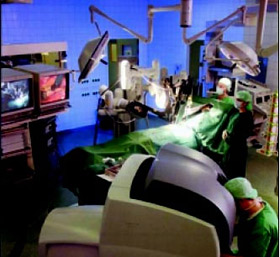Prostate cancer surgeons 'feel' with their eyes

Robotic surgical technology, with its 3-D, high-definition view, gives surgeons the sensation of touch while they operate from a remote console.
A new study published in the March issue of the British Journal of Urology International reports that surgical outcomes for prostate cancer surgery using this minimally invasive robotic technology compare favorably with traditional invasive surgery.
Led by physician-scientists at NewYork-Presbyterian Hospital/Weill Cornell Medical Center, the study is the first to show that a lack of tactile feedback during robotic surgery does not adversely impact outcomes in patients with prostate cancer. It also identified various visual cues that surgeons can use to improve clinical outcomes.
"Anatomical details and visual cues available through robotic surgery not only allow experienced surgeons to compensate for a lack of tactile feedback, but actually give the illusion of that sensation," says Dr. Ashutosh Tewari, the study's lead author; professor of urology, urologic oncology and public health at Weill Cornell Medical College (WCMC); and director of the Lefrak Center of Robotic Surgery and the Institute of Prostate Cancer at NewYork-Presbyterian Hospital/Weill Cornell Medical Center. "For patients, this means the safety of knowing the benefits of a robotic approach -- including a quicker recovery -- don't compromise the surgery's primary mission of removing the cancer."

In recent years, robotic-assisted laparoscopic prostatectomy (RALP) has become a popular surgical method for treating prostate cancer because it is less invasive than traditional surgery. Cancer cells produce changes in tissue firmness that surgeons can sense. Because this tactile evaluation is not possible for surgeons using RALP, clinicians have wondered whether the robotic approach could lead surgeons to miss some cancer, and thus subject patients to a greater risk of cancer recurrence.
To find out, the investigators videotaped 1,340 RALPs and examined the pathology results of the prostate that was removed to determine the incidence of positive surgical margins, an indication that a surgeon might not have removed all of the cancer.
The investigators found that robotic surgery did not compromise outcomes.
The researchers say that the enhanced vision allowed by the robotic approach brings about a "reverse Braille phenomenon" or the ability to "feel" when vision is enhanced. They have identified a number of visual cues that clinicians can use to improve outcomes, including the color of tissue, the location of veins as a landmark for the location of nerves, signs of inflammation and appreciation of so-called compartments outside the prostate.
Co-authors include Dr. Maria M. Shevchuk, the study's senior author, associate professor of pathology at WCMC and a pathologist at NewYork-Presbyterian.
Media Contact
Get Cornell news delivered right to your inbox.
Subscribe